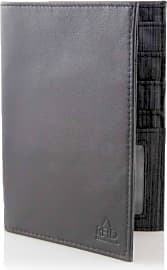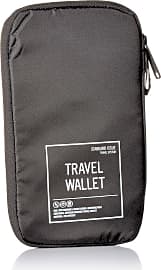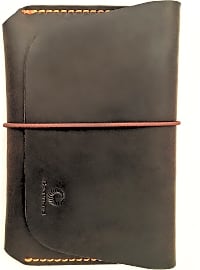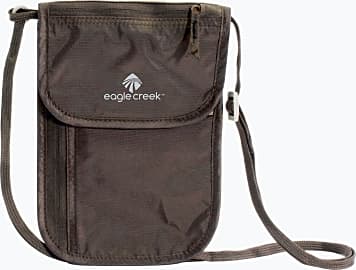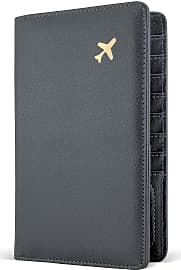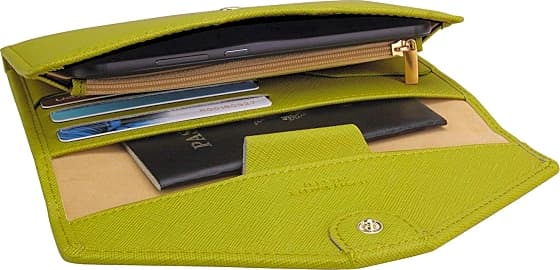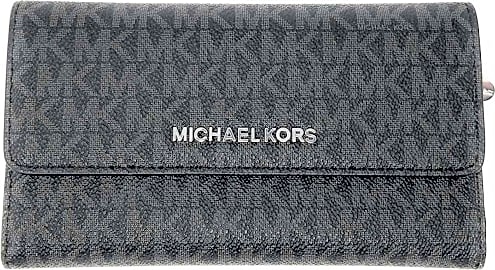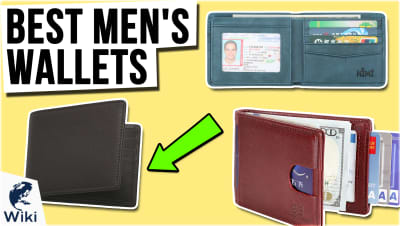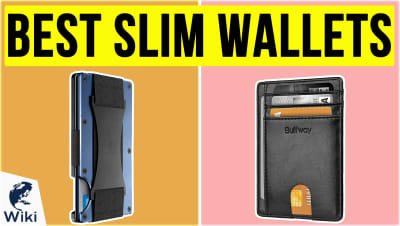The 10 Best Travel Wallets

This wiki has been updated 40 times since it was first published in April of 2015. Nothing says, "I'm a tourist carrying a lot of cash; please rob me," like a bulky billfold poking out of a back pocket. That's why we've done the legwork to provide you with this selection of the best travel wallets. Many are big enough to function as passport holders without being too unwieldy, and some even offer RFID protection, which keeps your information safe from identity thieves. When users buy our independently chosen editorial picks, we may earn commissions to help fund the Wiki.
Editor's Notes
May 19, 2021:
We thought the last editor for this page did a good job of curating a nice mix of options that contained just the right amount of variety, in terms of style and utility, but we did notice that a couple of options – the Travelambo Envelope and Enroute Leg – looked like they might no longer be available, so we went ahead and removed them from the list. In their places, we added the Allett 22501RF and Herschel Standard Issue.
We liked the 22501RF because, in a category full of bulky accessories loaded with a litany of complicated compartments, it looks a lot like a standard wallet. Granted, it’s a bit taller than most models, but that’s to be expected of any option that can comfortably house a passport. Its full-grain leather construction also makes for a classier look than a lot of the nylon alternatives seen elsewhere, and we thought that including two separate pockets to help keep different currencies sorted was a nice touch.
The Standard Issue is a bit on the big size for standard pockets, but it's still small enough to stash in a fanny pack or a big enough pair of jeans. It’s a zippered option, too, so you could feasibly store your smartphone inside it, although there is another zipper inside that might be a scratch hazard. It has six card slots, but no window for your photo ID.
Travel wallets like the ones on this list are great for days spent maneuvering through airports, when you always want to keep your crucial documents on hand, but once you arrive at your destination you might find that hauling such a big accessory around everywhere is a pain. So, if you’ve got somewhere safe to lock your passport up while you’re vacationing, then it might not be a bad idea to also pack a slim wallet, for daily carrying.
March 03, 2020:
At this time, we've opted to remove the Shacke Hidden and the Wellspring Ideas Shoulder Pocket over concerns about their ease of use. In theory, their safety features make sense, but for a segment of travelers, they require a lot of rummaging or awkward movements, which can complicate things when it's time to pay. But we have kept a couple of neck wallets, including the Venture 4th Stash and the Eagle Creek Undercover. These also require different usage than a standard wallet (the kind that fits in your purse or pocket), but the peace of mind they can provide makes them worth it to many. There's also the Raytix Money Belt, which, as you can well guess, is a travel money belt that was created specifically to remain hidden. It can still be seen under very tight clothing, of course, but for the most part, it does a good job of staying concealed.
As for options that do look like standard wallets, we've selected the Zoppen Tri-Fold and kept the Travelambo Envelope. They're both available in a stunning array of color choices, and they both have a snap closure. This lack of a closure is a problem for some when it comes to the Pockt Holder, although it's still a good option for travelers who want something that's as simple as possible. And, finally, we've opted to remove the rather bulky Pacsafe Luggage RFID-Tec. The styling isn't anything to write home about, as opposed to the Michael Kors Jet Set, which isn't exactly small, but is sleek and handsome. The Michael Kors trifold is a little pricey, though.
Special Honors
My Montblanc Nightflight Travel Companion Blurring the line between bag and wallet is the My Montblanc Nightflight Travel Companion, which is bigger than most travel wallets, and with a beefier price tag to match. But for those who love organization and need the extra space, it's well worth it, thanks to an array of pouches, pockets, and compartments. montblanc.com
Smythson Panama Slim Made in Italy, the Smythson Panama Slim is luxurious with its crossgrain calf leather exterior and sleek, just-the-essentials construction. And because it features top-notch materials and craftsmanship, you can count on it for the long haul, no matter how many flights it sees you through. smythson.com
Tumi Voyageur Although the Tumi Voyageur is lightweight and made for travel, it looks much like a standard long billfold or wallet, so it won't draw too much attention. The security it offers is excellent, however, with a zip pocket on the flap that keeps everything right where you put it. tumi.com
Guide to Travel Wallets
We compiled a short guide addressing the basic travel wallet styles, including the advantages and disadvantages of each.
With so many travel wallet styles, which type is best for you? We compiled a short guide addressing the basic travel wallet styles, including the advantages and disadvantages of each.
Money belts are designed to look like regular belts, but feature a concealed compartment to hold currency and other small documents or valuables. They offer adjustability and comfort to travelers who want something inconspicuous. They usually don't accommodate passports or large items, and do not provide quick nor easy access to cash. Best for travelers looking to subtly store excess cash, but you will have to remove it for TSA.
Leg pouch wallets strap onto the leg, and can hold a passport, currency, and cards. Easily concealed by pants, this wallet is a good option for travelers who will be active and don't want to carry something uncomfortable. Some users may find this wallet type to be inaccessible when worn underpants.
Waist wallets, perhaps the most popular type of travel wallet, is worn around the waist and feature a pouch that can be hidden under a shirt. They are easily accessible and many travelers feel that their valuables are safer. They can be worn with both tight and loose clothing, and are typically adjustable. Unfortunately, because they are so popular, most thieves know to look for them. Great for those who prioritize comfort.
Shoulder holster wallets feature backpack-like straps worn around both arms, with a pouch on one shoulder. They can hold a large volume of valuables, offer the highest degree of accessibility, and can be concealed by a jacket or sweater. This design is more secure as it uses more straps and would be difficult for a thief to remove. Best for people who prioritize accessibility.
Neck pouches are worn around the neck and flat against the chest underneath a shirt. Some feature a steel security wire, making it very difficult for thieves to cut the strap off. These can be worn by both men and women, but women may want to adjust theirs to hang off their stomach to maintain a flat profile. While secure, neck pouches may become uncomfortable in the heat and are difficult to access without removing one's shirt.
How to Avoid Theft While Traveling
You probably know someone who has been a victim of theft while traveling, or maybe it's already happened to you. Tourists are easy targets for thieves, but fortunately, there are several steps you can take to prevent theft. To help you stay safe during your trip, we compiled a guide with steps you can take before and during your travels to keep your safety a priority.
Before You Travel
Travel safety starts at home, before you embark on your journey.
Backup your electronics. If you're bringing any electronics, such as a laptop or cellphone, make backups of these items before you leave. If you can, have these items backup to the cloud so that you can continue to make frequent backups during your trip—this is especially good to do if you're taking photos on a digital camera. If you have Apple devices, enable the Find My iPhone, iPad, and Mac feature. Android users can use the Android Device Manager.
Scan and photocopy important documents. Along similar lines, it is crucial to scan your passport, ID, credit cards, etc. into a secure digital location in the event that any of these things are stolen. Having copies of these documents speeds up the amount of time it takes to replace them. Bring a photocopy of your passport or ID with you for local travel on days that you choose to leave your passport in the hotel.
Consider getting travel insurance. Travel insurance is available in many coverage types, but health insurance will almost always be a worthy investment. You might also consider insuring your expensive electronics or other valuables, such as a laptop. If you do insure valuables, photograph these items at home in case you need to file a claim later.
Research the safety of your destination. Before you go, read about staying safe in the city you're traveling to. Are there dangerous neighborhoods? Are there any common theft schemes? Once you're there, talk to locals to get a good sense of this.
Avoid using outwardly expensive luggage. If you're about to take a trip to Rio de Janeiro, don't bring your Louis Vuitton luggage. This should be a no-brainer. While you're at it, be mindful of any other outward displays of wealth: they'll mark you as a target with a lot of other goods worth stealing.
If you're traveling with someone, arrange for them to stay with your bags while you grab food or vice versa.
At the Hotel
Develop an unpacking routine. Each time you unpack and repack, take a mental inventory of your things, ensuring that your most important things weren't stolen on the way there. In the hotel room, don't put things in places you'll forget them. Do a thorough sweep of your hotel room before you leave.
Leave valuables at your hotel during the day. Your things will almost definitely be safer in the hotel than on your person, especially if you take advantage of the safes offered by many hotels and hostels. That said, make efforts to conceal valuables in the room—don't just leave them visibly laying around. Of course, if you're staying in a shared hostel, you may want to consider bringing valuables with you. Alternately, you might bring a chain and/or padlock so that you can chain your bag to a piece of furniture in the room. It doesn't make stealing your bag impossible but it does act as a deterrent. When traveling locally, leave your passport at a hotel safe and bring your photocopy with you instead.
While Traveling
Invest in a travel wallet. Travel wallets keep your most important documents concealed and secured to your body, greatly reducing the chances of theft. Choosing the right travel wallet will be dependent on what you're carrying and what's comfortable for you, but in general, having a travel wallet that straps to your body keeps things significantly more secure than a regular wallet. Check out our recommendations above! If you do opt for a regular wallet, don't keep it in your back pocket. A wallet in the back pocket asks to be stolen.
Keep track of your things. This is obvious but so important! Each time you leave somewhere or even so much as change positions, make sure you have all your things, especially your phone, wallet, passport, keys, etc. Make a habit of glancing back to wherever you just were and scanning the table, seat, and ground before leaving. This is especially important in case something fell out of your pocket or you left something on a table.
Don't casually set things down on the table. If you're at a restaurant, say, don't set your phone or camera carelessly on the table while you're eating. Leaving things on the table attracts thieves who could easily snatch these things.
Fasten your bag. Even the smallest obstacles can be a deterrent to thieves, so make your bag and the contents inside less accessible. When sitting in public, especially at a train station or airport, when grabbing a bite to eat, or just resting, try to fasten a strap of your bag around your leg or a chair. Anything that attaches your bag to something else will make it more difficult for a thief to quickly grab it. Also, consider getting a lock for the zippers on your bag, or take Rick Steves' suggestion and use a paperclip or twist-tie. As Steves writes, "the point isn't to make your bag impenetrable, but harder to get into than the next guy's."
Don't look like a tourist. Easier said than done, but tourists are easy targets because they're usually clueless and carrying a lot of valuables. Try blending in with the locals and look like you know what you're doing. Paper maps, puzzled faces, and expensive DSLRs are dead giveaways for tourists. You can also check out this guide or find guides online with advice that pertains to your specific destination.
Keep sources of cash separate. Don't keep all your cards and cash in one place, because if things are stolen from that place, you'll be left completely without money. Keep these things in different but secure locations. Review your bank's policy for emergency funds ahead of time in the event that your card is stolen during international travel. If it is stolen, notify your bank immediately. You can read more about dealing with stolen credit cards here.
Maintain physical contact with your bags. When waiting at train and airport terminals, keep your bags with you at all times. Even if it will only take two minutes to grab a Cinnabon and you don't want to bring your two giant suitcases with you because you're worried you'll lose your seat, trust me: it's not worth it. If you're traveling with someone, arrange for them to stay with your bags while you grab food or vice versa.
Protect baggage claim tickets, coat check tickets, and locker keys. Treat these like important documents and keep them in a secure place. If a thief gets hold of them, they're basically golden tickets to your most important belongings.
Be vigilant and aware of common theft schemes. Thieves are smart and have developed hundreds of ingenious ways to steal from travelers. Some involve making public commotions that act as distractions, while others are as simple as getting the victim's attention by pretending to steal from one pocket, only to have someone else steal from the other pocket while the victim is distracted. The newest type of theft is wireless identity theft, enabled by radiofrequency devices that can access information stored on RFID chips. Educate yourself about these schemes beforehand so that you know what to be wary of. Check out this guide and this guide to get started.
History of Wallets
Ever wonder where wallets come from?
Before the wallet, there was the coin purse, which first emerged during classical antiquity. These coin purses were really more like knapsacks, comprised of small fabric pouches with a drawstring. The 20th-century classicist A. Y. Campbell determined that these proto-wallets were made to hold coins and basic provisions—a lunchbox of sorts.
Before the wallet, there was the coin purse, which first emerged during classical antiquity.
The wallet as we know it first appeared in the 1600s, marked by Shakespeare's mention of it in his 1609 tragedy, "Troilus and Cressida." Its development came following the introduction of paper currency in the West, and more specifically the 1690 introduction of currency to the New World, after which the commonly used coin purses became more obsolete. These wallets were often made out of leather and included separate compartments for smaller items.
In the 1800s, wallets became more common and were used for carrying anything ranging from personal items to dried meats. During this time, wallets were commonly worn on the belt, which was considered "semi-civilized." In parts of Europe, and especially Spain, the wallet was used to carry smoking accessories, including tobacco, yesca, rolling papers, spices, and flint. This can be read about on pages 177-78 in this 1832 account of Spain by Caroline Elizabeth Wilde Cushing, which details the process (also check out this early reference to pickpocketing and malhechores on page 169). As with most commodities, the wallet was made cheaper and more available by the industrialization that took place in the 19th century.
The credit card, first invented in 1950, served as the antecedent to the modern-day wallet, necessitating slots to hold and separate the plastic cards. Nowadays, you can find wallets that hold checkbooks, wallets with coin purses, bi-fold and tri-fold wallets, and even our own niche favorite: the travel wallet.



